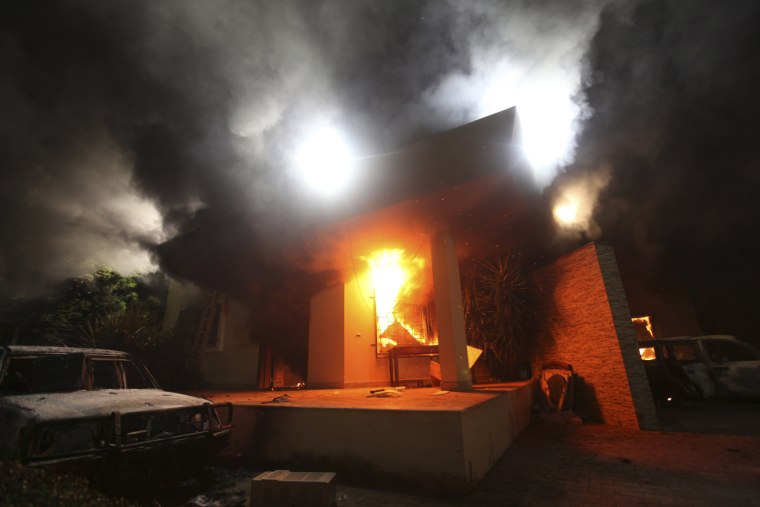WASHINGTON -- A senior intelligence official has issued a new timeline for the events surrounding the attack on the U.S. Consulate in Benghazi, Libya, indicating a series of tragic miscalculations that left CIA officers exposed at an annex near the consulate -- but no evidence of interference from Washington or of the CIA witholding aid from the State Department, as Republican critics have alleged.
According to the timeline, CIA officials in Libya sent a security team to the consulate within 25 minutes of the report of the attack, and the U.S. military sent an unarmed drone to provide intelligence information.
Four Americans, including Ambassador Christopher Stevens, information management officer Sean Smith and security personnel Tyrone Woods and Glen Doherty, were killed in the attack Sept. 11-12.
Questions have been raised about whether the consulate had adequate security and whether the State Department responded appropriately to requests for more protection.
Also, immediately after the Benghazi attack, U.S. spy agencies produced conflicting reports on who was behind them, U.S. officials have said. Most said extremists with possible al-Qaida ties were involved. But a few reports, which the Obama administration emphasized in public statements, said the attacks could have been spontaneous protests against an anti-Muslim video made in the U.S.
According to the senior intelligence official:
- The officers on the ground in Benghazi responded quickly to the attack, risking their lives in an attempt to rescue those at the consulate.
- There was no second-guessing of decisions made on the ground and no order to anybody to stand down in providing support. "At every level in the chain of command, from the senior officers in Libya to the most senior officials in Washington, everyone was fully engaged in trying to provide whatever help they could," the official said.
- The U.S. military provided essential support, including sending an unarmed drone and medical evacuation.
- Two U.S. security teams were involved -- one that was sent from the annex to the consulate and a tactical support team that was sent from Tripoli, each composed of approximately half a dozen security officers. Two U.S. military officers were on the team from Tripoli.
The chain of events described in the timeline:
-- Around 9:40 p.m. local time, the first call comes in to the annex that the consulate is under attack.
-- Fewer than 25 minutes later, a security team of about half a dozen leaves the annex for the consulate.
-- Over the next 25 minutes, team members approach the compound, attempt to secure heavy weapons from Libyan allies and make their way into the compound under fire.
-- At 11:11 p.m., an unarmed drone that had been requested from the U.S. military arrives over the compound.
-- By 11:30 p.m., all U.S. personnel, except for the missing ambassador, depart the compound in vehicles under fire.
-- Over the next roughly 90 minutes, the annex receives sporadic small-arms fire and rounds from rocket-propelled grenades; the security team returns fire, and the attackers disperse about 1 a.m.
-- At about the same time, the second team of security personnel lands at the Benghazi airport and tries to negotiate for transport into town. Upon learning Stevens was missing and that the situation at the annex had calmed, their focus becomes locating him, perhaps at a local hospital.
-- Still before dawn, the team at the airport secures transportation and armed escort and -- having learned that the ambassador was almost certainly dead -- heads to the annex to assist with the evacuation.
-- The second team arrives with Libyan support at the annex at 5:15 a.m., just before the mortar rounds begin to hit the annex. The two security officers were killed when they took direct mortar fire as they engaged the enemy. That attack lasted only 11 minutes then also dissipated.
-- Less than an hour later, a heavily armed Libyan military unit arrived to help evacuate all U.S. personnel.
Earlier Thursday, State Department spokesman Patrick Ventrell said a review board has been set up to examine the Benghazi attack and the government's response before and after the assault.
Catherine Chomiak is an NBC News producer. Andrea Mitchell is NBC News' senior foreign affairs correspondent.
More world stories from NBC News:
- Analysis: Israel, Iran name checks illustrate America's twin obsessions
- China opposition party lasts a day, founder gets 8 years in prison
- Meet Afghan female rapper, colonel who defy the odds
- Analysis: Should next president treat Russia as friend or foe?
- Expert: Tourists threaten Sistine Chapel's famous paintings
- Oasis of tolerance or 'Republic of Shame'? Two faces of gay life in Beirut
- The secret to a perfect smile? Chopsticks, Chinese officials are told
- After decades of oppression, Kurds get taste of freedom in Syria
